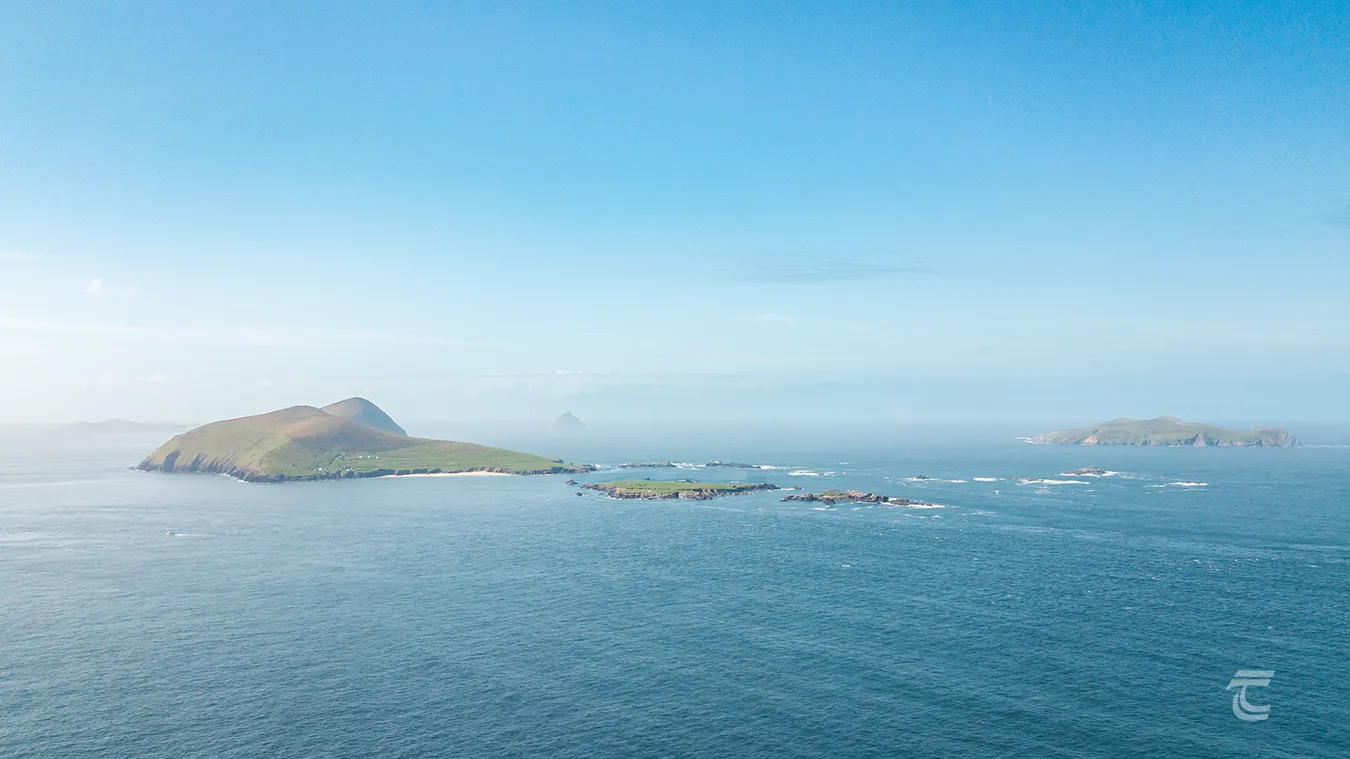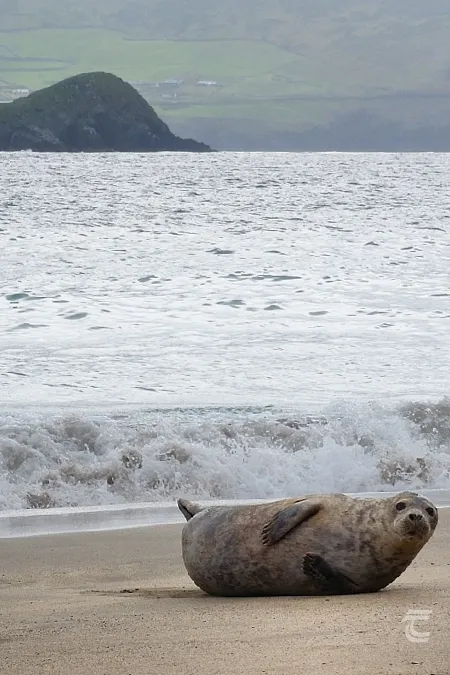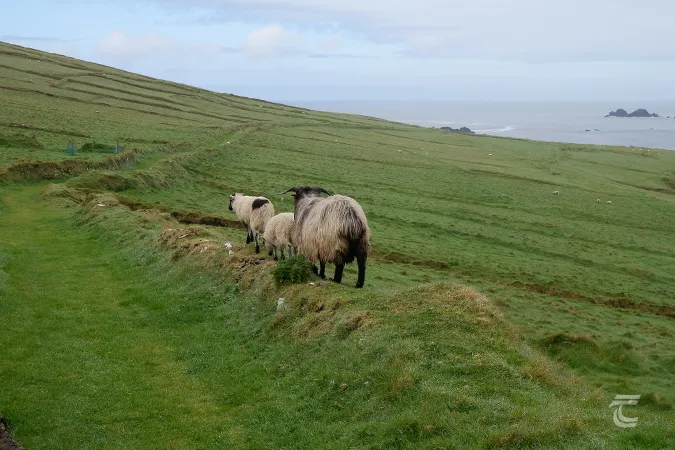Great Blasket Island
The Great Blasket Island (An Blascaod Mór) is the largest among a group of six islands off the west coast of Co. Kerry. Rounding the famous Slea Head drive, the Blasket Islands and far Atlantic horizon come into view, disappearing and reappearing as headlands protrude and fall back into the shadow of Mount Eagle. The shifting light and temper of the waves dictate whether the Great Blasket appears within touching distance or entirely cut-off, separated from the mainland by the turbulent Blasket Sound. This island was once home to Ireland’s best-loved storytellers, who put down in writing the lived experience of life on this remote island. The Great Blasket has captured the imaginations of visitors to Ireland’s most-westerly point for centuries.
For practical information about visiting this site Click Here

Aerial view of the Blasket Islands taken from above Dunmore Head • West Kerry
A Living Heritage

The island settlement at dusk • Great Blasket Island
From the pier in Dunquin, one can easily make out the crumbling ruins of the island’s once bustling village. Now deserted, paths previously worn by footsteps are overgrown, and the island’s once busy village, with its school, meeting house, and cottages are mostly roofless shells. Following a continuous decline in population, the traditional way of life on the island became increasingly unsustainable. Regularly unable to travel to the mainland for weeks at a time, the ravages of both weather and age began to tell on the remaining islanders. The last inhabitants were evacuated in 1953 and, for the first time in at least two hundred years, the Great Blasket Island found itself uninhabited.
Despite leaving their home, the islanders appreciated the unique nature of their heritage. This heritage – from their cultural traditions to their particular dialect of the Irish language – had been attracting European scholars to the island since the end of the nineteenth century. These visitors held a mirror up to the people of the Great Blasket, allowing the islanders to recognise and appreciate their own cultural values, traditions, and practices. The Great Blasket is known throughout the world for its writers. Peig Sayers, Tomás Ó Criomhthain and Muiris Ó Súilleabháin detailed the experience of life in this remote place, ‘so that some record of us might live after us, for the like of us will never be again.’ Although the island has not been home to a community in decades, it continues to draw scholarly attention, as researchers look to the Blasket library in the study of Irish folklore, customs and traditions.
From the pier in Dunquin, one can easily make out the crumbling ruins of the island’s once bustling village. Now deserted, paths previously worn by footsteps are overgrown, and the island’s once busy village, with its school, meeting house, and cottages are mostly roofless shells. Following a continuous decline in population, the traditional way of life on the island became increasingly unsustainable. Regularly unable to travel to the mainland for weeks at a time, the ravages of both weather and age began to tell on the remaining islanders. The last inhabitants were evacuated in 1954 and, for the first time in at least two hundred years, the Great Blasket Island found itself uninhabited.
Despite leaving their home, the islanders appreciated the unique nature of their heritage. This heritage – from their cultural traditions to their particular dialect of the Irish language – had been attracting European scholars to the island since the end of the nineteenth century. These visitors held a mirror up to the people of the Great Blasket, allowing the islanders to recognise and appreciate their own cultural values, traditions, and practices. The Great Blasket is known throughout the world for its writers. Peig Sayers, Tomás Ó Criomhthain and Muiris Ó Súilleabháin detailed the experience of life in this remote place, ‘so that some record of us might live after us, for the like of us will never be again.’ Although the island has not been home to a community in decades, it continues to draw scholarly attention, as researchers look to the Blasket library in the study of Irish folklore, customs and traditions.
Dipping the Oars: Going Into the Island

A seal enjoying An Trá Bán • Great Blasket Island (image Lesley Kehoe)
The sorrowful song of grey seals carries over the waves as you approach the island, the colony dominating the white sands of An Trá Bán. Beyond the shoreline, minke whales and basking sharks navigate the waves, occasionally joined by humpback whales and orcas as they head for deep water. The Great Blasket is a haven for wildlife. Manx shearwaters burrow into grassy ridges, evidence of a long-abandoned field system. Black-backed gulls perch on the ruins of old cottages while gannets, fulmars, guillemots, shags and skuas, among others, patrol the waves. Ravens circle high on the hills at An Dún, their caws piercing the din of the waves 1000-feet below. Peregrine falcons stay closer to the ocean’s surface as they occupy caves, once hiding places for folk heroes.
The Great Blasket Island is accessed by boat from Dunquin, Dingle or Ventry between April and October. Sailing is weather dependent. There is no pier on the island, and visitors must transship into a dinghy upon arrival. There are limited facilities available on the Great Blasket, so be sure to use toilet facilities at your point of departure and bring a packed lunch. The island terrain is steep and uneven, and appropriate footwear is essential. Be prepared for all weather – there is no shelter on the island, so rain jackets, sunscreen, hats and a change of socks are all advised!
Just across the waves on the mainland, the Blasket Centre in Dunquin provides remarkable insight into the story of the Great Blasket, from its literary heritage to its flora and fauna.
If you can’t make it to the island, catch up on our Tuatha Talk ‘Blasket Bound: The Story of the Great Blasket Island’ with Lesley Kehoe, who lived and worked on the island in 2019 and whose research focuses on the intangible heritage of the island.
Upper left: the Great Blasket Island • Lower left: sheep on the island (Image Lesley Kehoe) • Right: above Dunquin Pier looking towards the islands
Top: the Great Blasket Island • Middle: Above Dunquin Pier looking toward the islands • Bottom: sheep are the main residents today
Explore more sites on the Wild Atlantic Way




